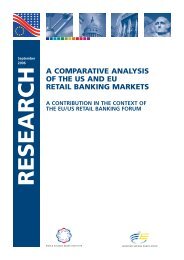Corporate Governance and Access to Finance - ESBG
Corporate Governance and Access to Finance - ESBG
Corporate Governance and Access to Finance - ESBG
Create successful ePaper yourself
Turn your PDF publications into a flip-book with our unique Google optimized e-Paper software.
The definition of <strong>Access</strong> <strong>to</strong> <strong>Finance</strong> presents certain differences in WBSImembers depending on the level of development of their countries.In emerging <strong>and</strong> developing countries, <strong>Access</strong> <strong>to</strong> <strong>Finance</strong> is closelyconnected <strong>to</strong> the notion of financial inclusion: the provision of access <strong>to</strong>appropriate, convenient, usable, valuable <strong>and</strong> affordable financialservices <strong>and</strong> products <strong>to</strong> the widest part of the population, especiallythrough the delivery of basic banking services <strong>to</strong> the low income people<strong>and</strong> the still unbanked, as a way out of poverty (WSBI SantiagoDeclaration). In industrial countries, where the majority of the populationhas access <strong>to</strong> financial services, the objective is <strong>to</strong> prevent <strong>and</strong> avoidfinancial exclusion, in particular in the case of the most vulnerable partsof the population (eg. unemployed, population in rural or remote areas,migrants, single parent households).While in the first case public policies should seek facilitating access <strong>to</strong> themiddle <strong>and</strong> low levels of the pyramid, in the second case they are typicallyaddressed at fighting segregation or discrimination against certainsegments of the society that, for different reasons, face difficulties inhaving access <strong>to</strong> formal financial services.The objective of <strong>Access</strong> <strong>to</strong> <strong>Finance</strong> needs <strong>to</strong> be balanced with the need<strong>to</strong> ensure the long term sustainability of the institution, in what the WSBIdefines as the “double bot<strong>to</strong>m line” banking model, according <strong>to</strong> whichsavings banks have a clear dual m<strong>and</strong>ate <strong>to</strong> (a) bring a return <strong>to</strong> thecommunities in which they operate, including <strong>to</strong> reach the unserved <strong>and</strong>underserved groups <strong>and</strong> (b) try <strong>and</strong> make a reasonable profit so that theoutreach achieved can be self-sustainable. There is no trade-off betweenfinancial inclusion <strong>and</strong> profitability <strong>and</strong> the two objectives pursued byWSBI members are mutually supportive.WSBI members have traditionally worked <strong>to</strong>wards fostering financialaccess as one of their main objectives. Consistent with this view, financialaccess occupies a prominent role in their mission statements <strong>and</strong>/or visiondesigns. Most of them have also adopted specific <strong>to</strong>ols <strong>to</strong> achieve thesetargets <strong>and</strong> set performance indica<strong>to</strong>rs that measure their results in termsof <strong>Access</strong> <strong>to</strong> <strong>Finance</strong>. WSBI members globally make a substantialcontribution in deepening financial inclusion (or combating financialexclusion) in their respective regions or countries.20
















